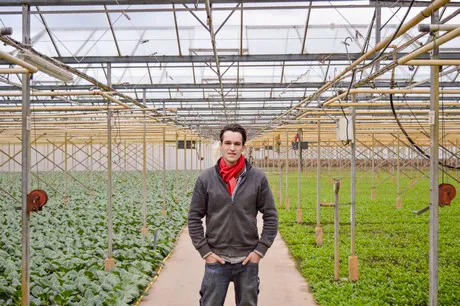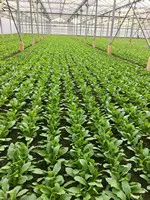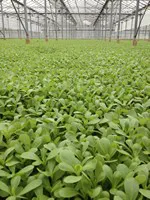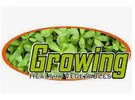His professors used to always be surprised: calluses on the hands of a student who was being prepared for a career in the financial sector. It wasn't anything out of the ordinary for Pim van Wingerden though, since he was practically raised with a scythe in his hand among the purslane and turnip greens.
Ever since he graduated Pim can be found at his full-time job in the greenhouse of Growing Healthy Vegetables. His father, Pim senior, started with the cultivation of typically Dutch vegetables there over fifty years ago. Unfortunately, he died at the beginning of this year, but Pim soldiers on, with a new season ahead of him in which, for the first time, they will be cultivating year-round purslane.

The 1.5 hectares of greenhouses used by Growing Healthy Vegetables doesn’t seem like a lot of surface area to work on when comparing it to the rest of the current greenhouse horticultural sector, but within their niche, they are the largest grower of purslane and turnip greens in the Netherlands. At the beginning of March, their greenhouse in Barendrecht is filled for one third with turnip greens, all neatly sown in rows and boxes. “When there is more light outside and the temperature becomes higher, the crops start growing faster and you need to start sowing less because if you don’t, you will end up with too much product all at the same time.”
Harvesting sooner is undesirable 
The turnip green season lasts from March till June. Purslane - summer purslane to be precise - on the other hand, takes a bit more time to cultivate during the spring. The first harvest of the leafy vegetable with its refined, sharp and crisp acidic taste is expected in April. The summer purslane season then continues up until the end of September.
The harvesting of the turnip tops is done by hand. Two hands, one bundle of turnip tops and one rubber band around it, something that Pim can do in his sleep. “We tried harvesting with machines once before, which went a lot faster but strangely enough this turned out to be a problem. The quality of the product remained the same, but all of a sudden the harvest only took two hours instead of the usual six. As a small company, that doesn’t need more than 2 or 4 people, you can’t expect your staff to come in for just two hours of work.”
When the product is harvested and neatly bundled up and packaged, it goes through fruit and vegetable wholesaler Bakker Barendrecht and eventually ends up in Albert Heijn supermarkets across the Netherlands. “Harvesting on a contract they call it, but it’s mainly a set of clear agreements regarding the quality, price and amount that help us plan out and deliver our cultivation better. This is a precise job for the turnip greens and purslane. There aren’t many growers who do this, and the ones that do mostly see it as something on the side. As soon as the supply becomes too much, it gets more difficult to sell the product because the demand doesn’t rise along with the supply. Not even Albert Heijn, which helps us with our marketing, can change that.”
Demand for trendy products stagnated
Both turnip greens and purslane are known as ‘forgotten vegetables’. In the last couple of years, the attention given to these type of vegetables grew and the demand has remained constant, but according to Pim the growing demand for his product has since been stabilized in the marketplace. “Our product is very susceptible to trends. Especially three or four years ago everyone was talking about ‘forgotten vegetables’, but now the focus in retail has shifted to soft fruit. That is the current trendy product, but it can change before you know it.”
Besides trends in the consumer and retail market, the weather is also an important factor when it comes to seasonal vegetables. “If the weather conditions are good, people make the decision to buy purslane to put in their salads more easily. The same goes for the turnip greens that are making their return to Dutch stews. For us, it is always most important to deliver a quality product, because the quality is what wins over the consumers. We always say: quality is what makes the consumer come back for more. Especially with a relatively expensive product like purslane, which easily costs around two or three euros per half kilo. This is not even a full meal, at least not for the younger generations that have different eating habits than the older generations."
Winter purslane at Christmas
To ensure they can cultivate year-round, the grower already has winter bok choy, butterhead, parsley and celery in the greenhouse during autumn. A test with lettuce in pots, living lettuce, ended in failure a few years back. “We were very enthusiastic, but the market less so. Without their positive feedback, you won’t get far.” However, this doesn’t mean that they aren't going to try out new things. “For a while now we have been asked to grow purslane year-round. This has led us to trying out LED lighting, but it resulted in too high of a price for retail.”
With a new product, real winter purslane, year-round cultivation for a reasonable price should be possible. “At the end of October, the winter purslane will be planted so it can be harvested around Christmas time. However, not much is known about them, to my knowledge, the only variety of winter purslane. The sprout and growth behavior of the crop are still largely unknown. Purslane has always been the company's baby, so I gladly accept the challenge of mastering this new type of cultivation.”
This article appeared in the 3rd edition, volume 33 of the AGF Primeur. See http://www.agfprimeur.nl/ for more information.
For more information:
Growing Healthy Vegetables
Pim van Wingerden
p.wingtrading@gmail.com
